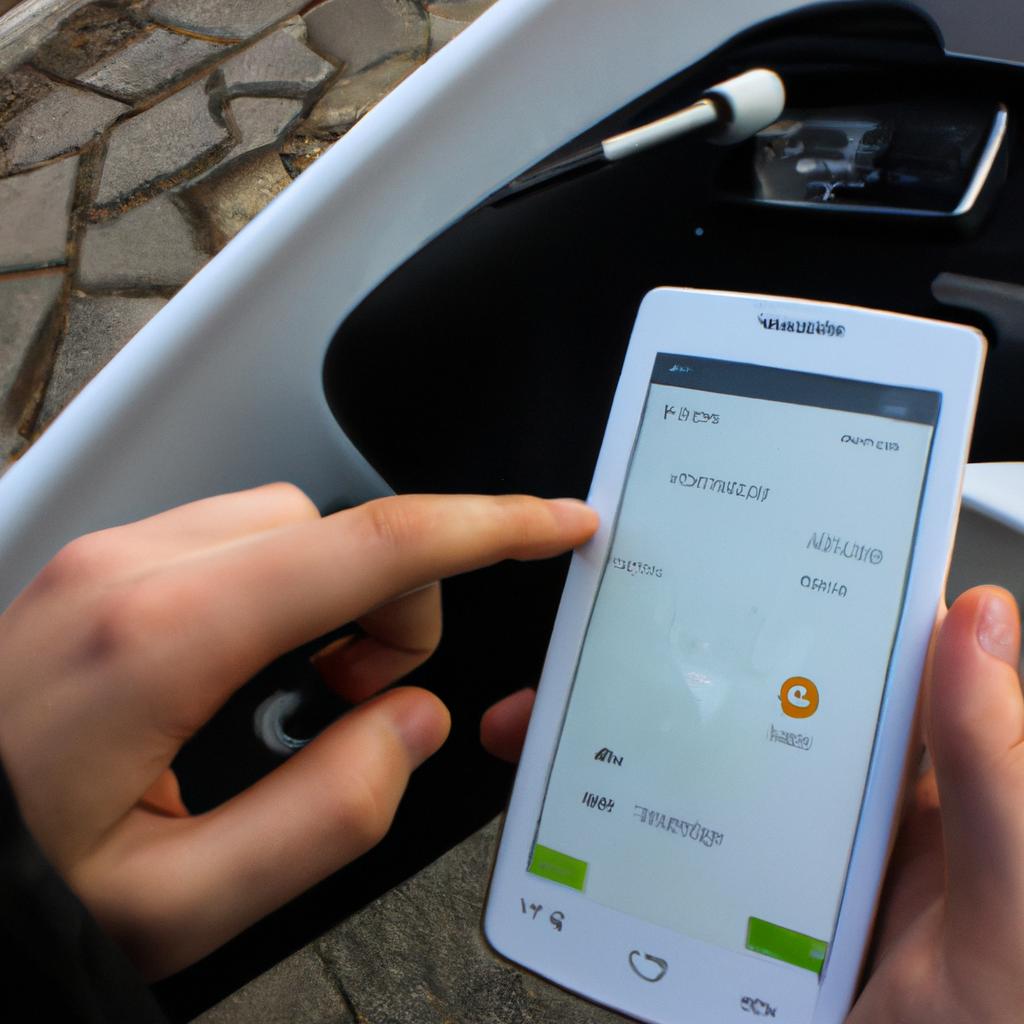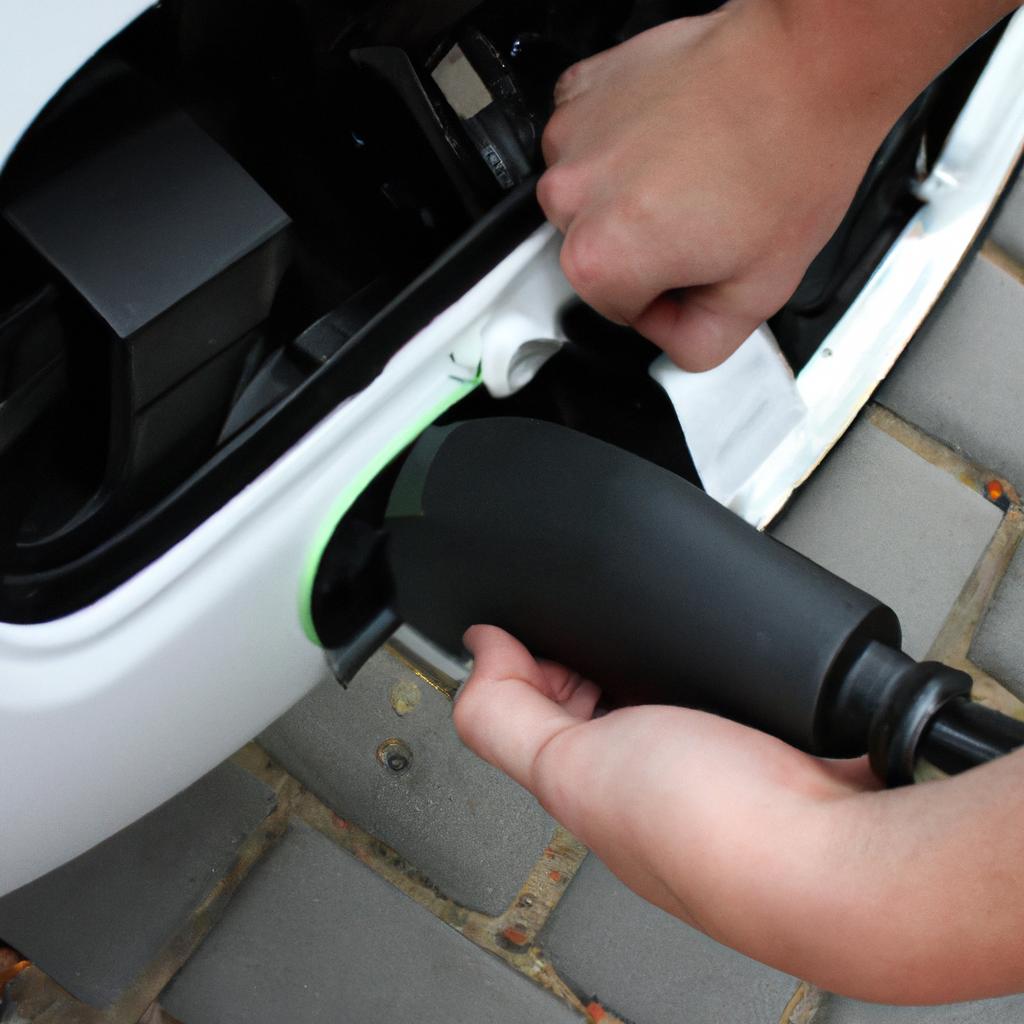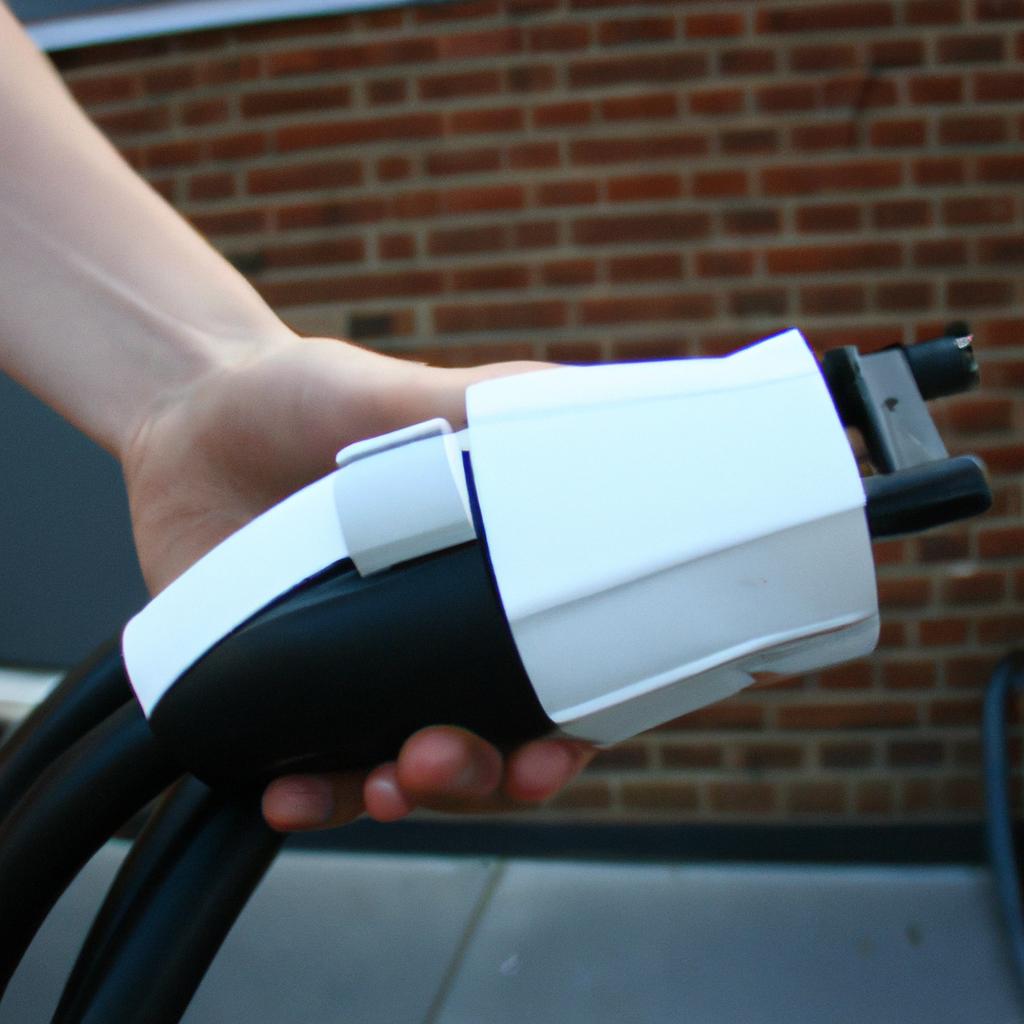Range estimates and electric vehicle (EV) range anxiety have become significant factors in the adoption of EVs. As consumers consider transitioning from conventional vehicles to EVs, they often express concerns about the reliability and accuracy of range estimates, which can contribute to their apprehension regarding potential limitations on travel distance. This article aims to explore the truth behind range estimates and electric vehicle range anxiety by examining various aspects such as technological advancements, driving habits, and charging infrastructure.
Imagine a scenario where an individual plans a road trip with their newly purchased electric vehicle. They study the estimated range provided by the manufacturer, meticulously plan each stop for recharging at available charging stations along the route, but still find themselves anxious about reaching their destination without running out of battery power. This predicament illustrates one aspect of what is commonly known as electric vehicle range anxiety – the fear or worry that an EV’s battery will not provide enough energy to complete a desired journey. Range anxiety can be experienced even when accurate range estimates are provided because drivers may feel uncertain about real-world performance under varying conditions.
To address these concerns surrounding range estimates and alleviate electric vehicle range anxiety, it is essential to delve into the complexities underlying this issue. By exploring advancements in technology that enhance battery efficiency and estimating algorithms, analyzing analyzing driving habits and their impact on range, and evaluating the current state of charging infrastructure, we can gain a better understanding of range estimates and alleviate electric vehicle range anxiety.
Technological advancements play a crucial role in improving battery efficiency and estimating algorithms. Battery technology has significantly evolved over the years, resulting in higher energy density and longer ranges for electric vehicles. Manufacturers are continuously investing in research and development to improve battery performance, allowing for more accurate range estimates. Additionally, advancements in computing power have led to sophisticated algorithms that take into account various factors such as weather conditions, terrain, and driving style to provide more precise range predictions.
However, it is important to note that range estimates are just estimates and may not always reflect real-world driving conditions. Factors such as aggressive driving, extreme temperatures, use of auxiliary systems (e.g., air conditioning), and payload can significantly impact the actual range achieved. Therefore, it is essential for drivers to understand their own driving habits and how they may affect their EV’s range.
Another key aspect of addressing electric vehicle range anxiety is evaluating the availability of charging infrastructure. The expansion of public charging networks plays a crucial role in alleviating concerns about running out of battery power during long journeys. The presence of fast-charging stations along major highways allows drivers to recharge their vehicles quickly while taking breaks or having meals. Moreover, home charging solutions enable EV owners to conveniently charge their vehicles overnight or during off-peak hours.
To further mitigate electric vehicle range anxiety, governments, utilities, and private stakeholders must continue investing in expanding the charging network to ensure sufficient coverage across urban areas as well as remote regions. This will provide reassurance to EV owners that they will have access to reliable charging options wherever they go.
In conclusion, addressing concerns surrounding range estimates and electric vehicle range anxiety requires a comprehensive approach that considers technological advancements in battery efficiency and estimating algorithms, analysis of individual driving habits impacting actual range achieved, and evaluation of the availability and expansion of charging infrastructure. By understanding these factors, consumers can make informed decisions about transitioning to electric vehicles and alleviate any anxiety related to range limitations.
The Importance of Accurate Range Estimates
Imagine you are planning a road trip in your brand new electric vehicle (EV), excited to explore the scenic countryside. You have carefully mapped out your route, taking into account charging stations along the way. However, as you embark on your journey, you realize that the estimated range provided by your EV is significantly different from what you had anticipated. Suddenly, anxiety sets in – will you reach your destination or be left stranded? This scenario highlights the significance of accurate range estimates for EV drivers.
Accurate range estimates play a crucial role in addressing one of the most common concerns among potential EV owners – range anxiety. Range anxiety refers to the fear or apprehension experienced by drivers regarding their EV’s ability to travel long distances without running out of battery power. It can discourage individuals from adopting EVs and hinder the widespread adoption of this sustainable transportation option.
To understand why accurate range estimates are important, consider the following points:
- Peace of mind: Accurate range estimates provide reassurance to drivers that they can confidently plan their trips without worrying about unexpected stops for recharging.
- Efficient route planning: With precise range information, drivers can optimize their routes based on available charging infrastructure, saving time and minimizing disruptions during their journeys.
- Increased confidence: When driver expectations align with actual performance, they gain trust in their vehicles’ capabilities and become more confident in choosing an EV over traditional internal combustion engine cars.
- Enhanced consumer experience: Providing accurate range estimates contributes to overall customer satisfaction and positive experiences with owning an EV.
In addition to these benefits, it is essential for manufacturers and policymakers to work together towards establishing standardized testing protocols that accurately reflect real-world driving conditions. By doing so, consumers can rely on consistent and reliable data when making informed decisions about purchasing an electric vehicle.
Moving forward, understanding the factors influencing electric vehicle range becomes paramount in improving accuracy. By examining these factors, we can identify opportunities for advancements in technology and infrastructure to address range anxiety effectively.
Factors Affecting Electric Vehicle Range
Accurately estimating the range of an electric vehicle (EV) is crucial in mitigating range anxiety and promoting widespread adoption. To illustrate this point, let us consider a hypothetical scenario where a driver plans to embark on a long-distance road trip using their EV. They consult the manufacturer’s estimated range, which claims that the vehicle can travel up to 300 miles on a single charge. However, unbeknownst to the driver, various factors can significantly impact the actual achievable range.
Firstly, weather conditions play a significant role in determining an EV’s range. Extreme temperatures, whether hot or cold, can reduce battery performance and efficiency. For instance, during colder weather, batteries tend to operate less efficiently due to increased internal resistance. As a result, the EV may not be able to achieve its full estimated range under such circumstances.
Secondly, driving behavior greatly affects an EV’s real-world range. Aggressive acceleration and deceleration consume more energy than smooth and gradual movements. Additionally, excessive speeding increases aerodynamic drag and reduces overall efficiency. By adopting eco-friendly driving habits like maintaining steady speeds and utilizing regenerative braking systems effectively, drivers can optimize their EVs’ potential mileage.
Thirdly, payload weight impacts an EV’s range capabilities as well. Carrying heavy loads or transporting multiple passengers will increase power consumption and decrease overall efficiency. Therefore, it is essential for drivers to be mindful of their cargo when considering distance traveled per charge.
Lastly, route planning plays a vital role in managing EV range expectations. Some routes may have limited charging infrastructure availability compared to others. Failing to account for these factors could lead to unplanned detours or even running out of battery power mid-journey – both contributing to heightened anxiety surrounding EV ranges.
To further emphasize the significance of accurate range estimates in addressing electric vehicle range anxiety and ensuring better user experience with EVs:
- Imagine being stranded on a remote road with no charging stations in sight, stressing about whether you will make it to your destination.
- Picture the frustration of having to modify your travel plans due to an unexpected lack of available charging infrastructure.
- Consider the inconvenience and anxiety caused by constantly worrying if your EV battery will last until the end of your journey.
- Reflect on the disappointment experienced when realizing that the actual range falls significantly short of what was promised.
In summary, accurate range estimates are crucial for addressing electric vehicle range anxiety. Weather conditions, driving behavior, payload weight, and route planning all impact an EV’s real-world range capabilities. Failing to consider these factors can lead to significant user dissatisfaction and hinder wider adoption of electric vehicles.
The subsequent section will delve into the comparison between real-world ranges and manufacturer estimates, shedding light on potential discrepancies and their implications for drivers.
Real-world Range vs. Manufacturer Estimates
Range Estimates and Electric Vehicle Range Anxiety: The Truth
The range of an electric vehicle (EV) is a critical factor that influences consumer perception and adoption rates. Understanding the various factors affecting EV range can help mitigate range anxiety and provide consumers with realistic expectations. For instance, let’s consider the case of Sarah, a new EV owner who experiences unexpected range limitations during her daily commute.
Firstly, weather conditions play a significant role in determining EV range. Extreme temperatures, both hot and cold, have been found to reduce battery performance. In colder climates, for example, low temperatures decrease battery efficiency by increasing internal resistance. This means that Sarah may experience reduced driving distance on particularly chilly mornings, leading to potential anxiety about reaching her destination without running out of charge.
Secondly, driving habits greatly impact EV range. Aggressive acceleration or frequent braking can drain the battery faster than smooth and controlled driving. Additionally, higher speeds tend to consume more energy due to increased wind resistance. If Sarah tends to drive quickly or has a habit of abrupt starts and stops, she may find herself needing to recharge sooner than expected.
Thirdly, payload weight affects EV range significantly. Carrying additional passengers or cargo increases the overall load on the vehicle, requiring more power from the battery to maintain speed. Suppose Sarah decides to take a road trip with friends while carrying camping gear in her EV. In this scenario, she might notice a considerable reduction in her vehicle’s driving range compared to when traveling alone without any extra luggage.
Lastly, ancillary features such as heating or air conditioning systems also influence EV range. Running climate control devices requires additional electrical power from the battery pack, potentially reducing available driving distance. If Sarah frequently uses these features during her commutes or long drives, it could further contribute to her concerns about running out of charge prematurely.
To emphasize the emotional aspect of electric vehicle range anxiety for readers:
- Fear: The fear of being stranded on the road with no charging station nearby.
- Frustration: The frustration experienced when a planned trip needs to be altered due to range limitations.
- Relief: The relief felt when reaching a charging station after driving on low battery for an extended period.
- Excitement: The excitement of discovering new technologies and strategies that can extend EV range.
| Fear | Frustration | Relief | Excitement |
|---|---|---|---|
| Stranded | Altered plans | Reaching charger | New technologies |
| No charging | Range anxiety | Low battery | Extended range |
| Isolated | Inconvenience | Peace of mind | Sustainable future |
In conclusion, several factors influence electric vehicle range, including weather conditions, driving habits, payload weight, and ancillary features. Understanding these factors helps consumers set realistic expectations regarding their EV’s driving distance. By considering real-life scenarios like Sarah’s daily commute, we can address common concerns associated with range anxiety and provide guidance for potential EV owners.
Moving forward to the next section about “Strategies for Mitigating Range Concerns,” let us explore various approaches that can alleviate electric vehicle drivers’ worries about running out of charge during their journeys.
Strategies for Mitigating Range Concerns
While electric vehicles (EVs) have gained popularity in recent years, concerns about their range and the phenomenon known as “range anxiety” persist among potential buyers. In this section, we will explore the reality of EV range compared to manufacturer estimates and provide insights into mitigating these concerns.
To illustrate the variation between real-world range and manufacturer estimates, let’s consider a hypothetical scenario: Sarah owns an EV with a manufacturer-claimed range of 250 miles on a full charge. She plans a road trip covering approximately 200 miles to visit her family in another city. Based on the estimated range provided by the manufacturer, Sarah assumes she has sufficient charge for the journey without requiring any additional charging stops.
However, upon embarking on her trip, Sarah encounters unexpected factors that impact her vehicle’s actual range. Strong headwinds increase aerodynamic drag, hilly terrain requires more power from the battery, and heavy traffic reduces efficiency due to frequent acceleration and deceleration. As a result, Sarah finds herself needing to locate charging stations along her route to ensure she reaches her destination comfortably.
To further understand how real-world conditions can affect EV range, consider the following points:
- Temperature extremes: Cold weather decreases battery performance while hot weather increases energy demand for cooling systems.
- Driving style: Aggressive driving habits such as rapid acceleration or excessive braking can significantly reduce overall range.
- Payload weight: Carrying heavier loads impacts efficiency and reduces available range.
- Road conditions: Uneven surfaces or constant stop-and-go traffic can diminish an EV’s mileage capabilities.
The table below summarizes some key factors affecting EV range:
| Factors Affecting EV Range | Impact on Range |
|---|---|
| Temperature Extremes | Decreases |
| Driving Style | Reduces |
| Payload Weight | Diminishes |
| Road Conditions | Affects |
Understanding the potential impact of these factors can help drivers better manage their expectations and plan for longer trips, reducing range anxiety in the process.
Transitioning to the subsequent section about “The Role of Charging Infrastructure,” it becomes evident that while understanding real-world EV range is crucial, having access to reliable charging infrastructure plays an equally significant role. By examining both aspects together, we can gain a comprehensive perspective on addressing concerns related to electric vehicle range.
The Role of Charging Infrastructure
One example that illustrates the effectiveness of strategies to mitigate range concerns is the case of a long-distance traveler who relies solely on an electric vehicle (EV) for transportation. This individual, let’s call him James, planned a road trip across several states in his EV. Initially, he was apprehensive about potential range limitations and anxieties associated with finding charging stations along the way. However, by employing various strategies to alleviate these concerns, James successfully completed his journey without experiencing any significant setbacks.
To address range anxiety and ensure a smooth travel experience, there are several effective strategies that can be employed:
-
Trip planning tools: Utilizing advanced trip planners or smartphone applications specifically designed for EV drivers can greatly assist in mapping out routes that include convenient charging station locations en route. These tools take into account factors such as distance between charging points, availability of fast-charging stations, and estimated charging times based on battery capacity.
-
Public charging networks: Accessing established public charging networks provides reassurance to EV drivers when planning longer trips. Networks like Tesla’s Supercharger network or third-party providers like ChargePoint offer widespread coverage and reliable infrastructure at key intervals along major highways and popular driving routes.
-
Workplace and home charging solutions: Installing dedicated chargers at home or utilizing workplace charging facilities significantly reduces range anxiety for daily commuting or local errands. Having easy access to overnight or daytime charging options ensures consistent battery replenishment without relying solely on public infrastructure during routine drives.
-
Battery management systems: Advanced battery management systems integrated within modern EVs play a crucial role in optimizing efficiency and extending overall driving range per charge cycle. These systems monitor energy consumption patterns, adjust power delivery accordingly, and provide real-time feedback to help drivers maximize their mileage.
Table 1 below highlights some common challenges faced by EV owners regarding range concerns and outlines corresponding mitigation strategies:
| Challenge | Mitigation Strategy |
|---|---|
| Insufficient charging infrastructure | Utilize trip planning tools to locate charging stations along the route |
| Limited battery capacity | Leverage workplace and home charging solutions |
| Range anxiety during long-distance travel | Access public charging networks |
| Uncertainty in estimating remaining range | Incorporate advanced battery management systems for accurate range predictions |
As technology continues to advance, significant developments are expected in the realm of electric vehicle range. With ongoing research and innovation, future EV models may offer increased driving ranges, shorter charging times, and more efficient energy utilization. These anticipated advancements will further alleviate concerns associated with limited range, making EVs an even more attractive option for consumers.
By exploring new materials and technologies for batteries, such as solid-state or lithium-air batteries, scientists aim to enhance energy storage capabilities and improve overall performance. Additionally, advancements in fast-charging infrastructure could drastically reduce charging times, making it comparable to refueling a conventional gasoline-powered vehicle.
In conclusion, strategies like utilizing trip planning tools, accessing public charging networks, implementing workplace and home charging solutions, and employing advanced battery management systems effectively mitigate range concerns faced by EV owners. Furthermore, future developments hold great promise for improving electric vehicle range capabilities. As we delve into the next section on “Future Developments in Electric Vehicle Range,” we will explore these exciting prospects in greater detail.
Future Developments in Electric Vehicle Range
The Role of Charging Infrastructure in Mitigating Electric Vehicle Range Anxiety
To address electric vehicle range anxiety, the availability and accessibility of charging infrastructure play a crucial role. A robust charging network instills confidence in EV drivers by ensuring that they have convenient access to charging stations when needed. This section explores the significance of charging infrastructure and its potential to alleviate range anxiety.
One example that highlights the importance of charging infrastructure is the case study conducted in a major metropolitan area. The study analyzed the impact of expanding the number of public charging stations on driver behavior and perceived range anxiety. Before the expansion, many EV owners expressed concerns about running out of charge during their daily commutes or longer trips. However, with an increased number of conveniently located chargers, this fear was significantly reduced, leading to greater adoption and usage of electric vehicles.
The benefits provided by well-developed charging infrastructure extend beyond addressing range anxiety. Consider these key aspects:
- Convenience: Accessible charging points at workplaces, shopping centers, and residential areas make it more convenient for EV owners to top up their batteries while going about their daily routines.
- Peace of Mind: Knowing that reliable charging options are readily available eliminates worries about running out of battery power during journeys.
- Increased Usage: With a robust charging network, more people feel confident making the switch to electric vehicles and utilizing them for various purposes such as long-distance travel without experiencing significant disruptions.
- Environmental Impact: Widespread use of electric vehicles supported by adequate charging infrastructure contributes to reducing greenhouse gas emissions and promoting sustainable transportation.
This table provides some statistics highlighting how effective implementation of comprehensive charging networks can enhance EV adoption rates:
| Country | Number of Public Chargers (2019) | Annual EV Sales (2019) | Percentage Increase in Sales Compared to Previous Year |
|---|---|---|---|
| United States | 68,800 | 331,100 | 23% |
| China | 1,225,000 | 1,204,000 | 5% |
| Germany | 27,730 | 63,281 | 61% |
| Norway | 11,295 | 75,917 | 9% |
By examining these figures and trends from different countries, it becomes evident that a robust charging infrastructure positively impacts EV sales. The availability of public chargers contributes to reducing range anxiety and encourages more individuals to embrace electric vehicles.
In summary, the role of charging infrastructure is vital in mitigating electric vehicle range anxiety. By providing convenient access to charging stations and addressing concerns about running out of power during journeys or daily commutes, a comprehensive network instills confidence in EV owners. Moreover, an expanded charging infrastructure supports increased usage and adoption rates while also contributing to sustainability efforts worldwide.
 Sfeva
Sfeva



